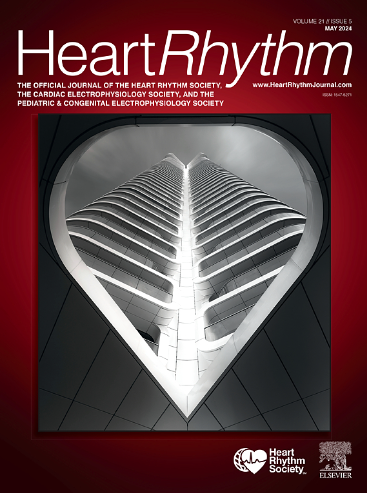Power-law properties of nocturnal arrhythmia avalanches: A novel marker for incident cardiovascular events
IF 5.6
2区 医学
Q1 CARDIAC & CARDIOVASCULAR SYSTEMS
引用次数: 0
Abstract
Background
Bursting nonsustained cardiac arrhythmia events are a common observation during sleep.
Objectives
The purpose of this study was to investigate the hypothesis that nocturnal arrhythmia episode durations could follow a power law, whose exponent could predict long-term clinical outcomes.
Methods
We defined “nocturnal arrhythmia avalanche” (NAA) as any instance of a drop in electrocardiographic (ECG) template-matched R-R intervals ≥30% of R-R baseline, followed by a return to 90% of baseline. We studied NAA in ECG recordings obtained from the Sleep Heart Health Study (SHHS), Osteoporotic Fractures in Men Study (MrOS) Study, and Multi-Ethnic Study of Atherosclerosis (MESA). The association of nocturnal arrhythmia durations with a power-law distribution was evaluated and the association of derived power-law exponents (α) with major adverse cardiovascular (CV) events and mortality assessed with multivariable Cox regression.
Results
A total of 9176 participants were studied. NAA episodes distribution was consistent with power-law vs comparator distributions in all datasets studied (positive log likelihood ratio of power-law vs exponential in MESA: 83%; SHHS: 69%; MrOS: 81%; power-law vs log-normal in MESA: 95%; SHHS: 35%; MrOS: 64%). The NAA power-law exponent (α) showed a significant association of with adverse CV outcomes (association with CV mortality: SHHS hazard ratio 1.39 [1.07–1.79], P = .012; MrOS hazard ratio 1.42 [1.02–1.94], P = .039; association with CV events: MESA HR 3.46 [1.46–8.21], P = .005) in multivariable Cox regression, after adjusting for conventional CV risk factors and nocturnal ectopic rate.
Conclusion
The NAA power-law exponent is a reproducible, predictive marker for incident CV events and mortality.
夜间心律失常雪崩的幂律特性:心血管事件的新标记。
背景:猝发性非持续性心律失常事件是睡眠中的常见现象:我们假设夜间心律失常发作持续时间可能遵循幂律,其指数可预测长期临床结果:我们将 "夜间心律失常雪崩"(NAA)定义为心电图(ECG)模板匹配 R-R 间期下降≥R-R 基线的 30%,随后恢复到基线的 90%。我们研究了睡眠心脏健康研究(SHHS)、男性骨质疏松性骨折研究(MrOS)睡眠和多种族动脉粥样硬化研究(MESA)心电图记录中的 NAA。研究评估了夜间心律失常持续时间与幂律分布的关系,并通过多变量 Cox 回归评估了得出的幂律指数(α)与主要不良心血管事件和死亡率的关系。在研究的所有数据集中,NAA发作分布与比较者分布相比均呈一致的幂律分布(MESA中幂律与指数的正对数似然比为83%;SHHS中为69%;MrOS中为81%;MESA中幂律与对数正态分布的正对数似然比为95%;SHHS中为35%):95%;SHHS:35%;MrOS:64%)。NAA 的幂律指数 (α)与不良 CV 结果有显著关联(与 CV 死亡率的关联:SHHS (HR = 1.39)SHHS(HR = 1.39[1.07-1.79],p=0.012);MrOS(HR = 1.42[1.02-1.94],p=0.039;与心血管事件的关系:MESA(HR = 3.0[1.07-1.79],p=0.012);NAA幂律指数(α)与不良心血管结局有显著关系:结论:NAA的幂律指数与心血管事件的发生有关:结论:NAA幂律指数是一个可重复的、可预测心血管事件和死亡率的指标。
本文章由计算机程序翻译,如有差异,请以英文原文为准。
求助全文
约1分钟内获得全文
求助全文
来源期刊

Heart rhythm
医学-心血管系统
CiteScore
10.50
自引率
5.50%
发文量
1465
审稿时长
24 days
期刊介绍:
HeartRhythm, the official Journal of the Heart Rhythm Society and the Cardiac Electrophysiology Society, is a unique journal for fundamental discovery and clinical applicability.
HeartRhythm integrates the entire cardiac electrophysiology (EP) community from basic and clinical academic researchers, private practitioners, engineers, allied professionals, industry, and trainees, all of whom are vital and interdependent members of our EP community.
The Heart Rhythm Society is the international leader in science, education, and advocacy for cardiac arrhythmia professionals and patients, and the primary information resource on heart rhythm disorders. Its mission is to improve the care of patients by promoting research, education, and optimal health care policies and standards.
 求助内容:
求助内容: 应助结果提醒方式:
应助结果提醒方式:


